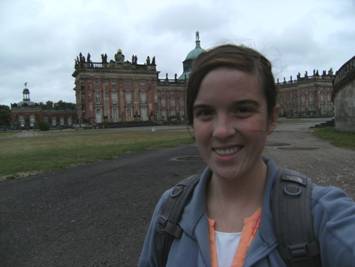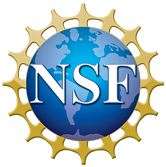International Collaboration
In January, 2008, two of the PIs on the BYU NIRT project, Robert Davis and Matthew Linford, traveled to the Max Planck Institute of Colloids and Interfaces in Golm, Germany to meet with Dr. Helmut Schlaad. Dr. Schlaad is a well-known German polymer chemist. Among his many accomplishments, he and his group have recently championed a new thiol-ene chemistry, which is a highly versatile method for functionalizing polymers. The NIRT group saw the Schlaad chemistry as, potentially, a powerful building block that could be applied to their nanotechnology efforts. During their trip, Davis and Linford spoke at the Max Planck Institute and had ample opportunity to meet with Schlaad. At the conclusion of their meetings it became apparent that their initial perceptions of the situation were correct – Dr. Schlaad was willing and interested in collaborating with them, he would accept students from the U.S. who might work in his lab, and the thiol-ene chemistry seemed to have a high probability of being useful in the NIRT project.
 NSF then very generously provided funds for two BYU students, a graduate student (Todd Wickard) and an undergraduate (Emily Nelsen), to spend three weeks each in Germany working in the Schlaad lab with two of his students: Christina Diehl and Niels ten Brummelhuis. This was the opportunity of a lifetime for them. Note the picture of Emily at one of the palaces at Sans Soucci, which is located in Potsdam, almost within walking distance of Schlaad’s lab – the palaces at Sans Soucci were build by Frederick the Great, and Johann Sebastian Bach visited Frederick at this location.
NSF then very generously provided funds for two BYU students, a graduate student (Todd Wickard) and an undergraduate (Emily Nelsen), to spend three weeks each in Germany working in the Schlaad lab with two of his students: Christina Diehl and Niels ten Brummelhuis. This was the opportunity of a lifetime for them. Note the picture of Emily at one of the palaces at Sans Soucci, which is located in Potsdam, almost within walking distance of Schlaad’s lab – the palaces at Sans Soucci were build by Frederick the Great, and Johann Sebastian Bach visited Frederick at this location.
Accordingly, Todd and Emily spent three weeks during in Summer 2008 making modified versions of 1,2-polybutadiene using the Schlaad thiol-ene chemistry. During this time they successfully synthesized, purified, and characterized nearly a dozen such polymers, which they brought back to BYU with them. Examples of the molecules they worked with include: 11-mercaptounedecanoic acid, 2-aminoethanethiol hydrochloride, 3-mercaptopropyl-trimethoxysilane, methyl 3-mercaptopropionate, triisobutylsilane, 1 H, 1 H, 2 H, 2 H – perfluoro-octanethiol, and 1-octanethiol. These novel polymers then formed the foundation of a new method for the functionalization of hydrogen-terminated silicon, and has in turn set the stage for nanodot modification that will allow DNA origami to be assembled into nanocircuits.
For example, after returning to the United States, Todd and Emily were able to show that modified polybutadiene would undergo a direct reaction with hydrogen-terminated silicon, which can be patterned for nanotechnology, and that this modified surface would then undergo a post-modification with another thiol. This approach to surface modification is truly powerful because of the flexibility it offers – polymers with high affinities for surfaces can be derivatized, attached to specific surfaces, and then further derivatized. This procedure potentially offers researchers a great deal of flexibility. There is now a manuscript in its latest stages of preparation on this subject that has Schlaad as a coauthor.
For the DNA origami aspect of the NIRT project, this approach will be invaluable, and work has begun in this direction. Indeed, it will offer a variety of considerable advantages. For example, our original work on silicon indicates that dithiol-modified gold surfaces, including gold nanodots, will react with polybutadiene. This polybutadiene will act to crosslink the dithiols to make an extremely stable base for coupling to DNA origami, which will be possible through residual carbon-carbon double bonds on the already-modified polymer.
The experience of working in our labs at BYU, combined with her work in Germany, along with very good grades and her other accomplishments, have put Emily in a strong position to be accepted to a top graduate school in chemical engineering (her major) or chemistry in a few years. Emily is currently being supported full time by an REU from NSF that is connected to our NIRT award. As an indication of how “marketable” she has become, Emily was awarded a fellowship/internship with the American Heart Association, and she will spend the last two months of this summer working at their site, before she returns to BYU and continues to work with us on the NIRT ASCENT project.
In September, 2008, Rob Davis and Matt Linford returned to Germany to again visit with Schlaad, as they had indicated they would do when they obtained the international award from NSF. This interaction went very well. Schlaad renewed his commitment to work with them on all of the projects they have moving forward. Linford will again meet with Schlaad at the American Chemistry Society meeting in August, 2009 in Washington, D.C.
We close this report on the international aspect of our work with a quote from Emily. Writing about her trip she noted:
“The trip to Germany was a fantastic experience. Not only did it present me with opportunity to explore the synthesis of polymers with a highly trained expert in the polymer field, but it also gave me a chance to travel abroad. I had not previously traveled internationally before my trip to Germany and was excited to be able to explore a different country while still participating in work applicable to my studies and interests. I fell in love with Germany: with the food, the people, the public transportation system (I could go anywhere!), and the landscape. It was a wonderful experience that almost seems too good to be true as I filter back through my memories. I am grateful for the opportunity I had to travel abroad to learn academic skills and to experience another culture. I highly recommend opportunities such as the one I had to travel to Germany as being a regular part of undergraduate studies.”

